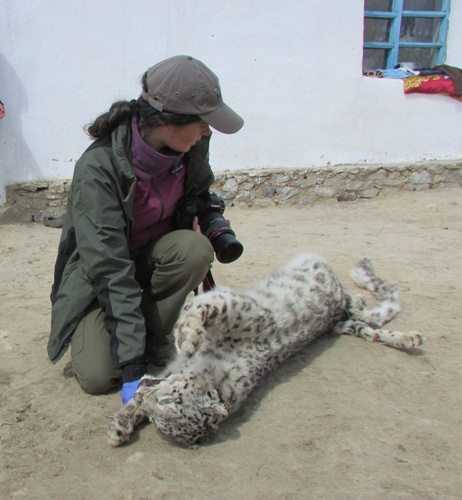Calling for wild cat conservation from the roof of the world
Working in what is dubbed the ‘roof of the world,’ Tanya Rosen is a passionate voice for the conservation of wild cats — snow leopards in particular.

Photo: Jura Bahriev
In the Pamir Mountains of Tajikistan, Tanya’s work as Snow Leopard Programme Coordinator for conservation organization Panthera aims to secure a future for one of the world’s rarest wild cats, nicknamed Asia’s Mountain Ghost because of its elusive nature.
The Pamir Mountains form the intersection of several of Asia’s greatest mountain ranges. They are a critical link between the southern and northern parts of the Snow Leopard range - a vital corridor for the species’ genetic interchange.
Snow leopards prey mainly on Marco Polo Sheep, Ibex and Markhor but extensive poaching of these animals by local communities is now a major threat to the leopards. Overhunting of prey species can force snow leopards to prey on villagers’ livestock, often resulting in the retaliatory killing of these big cats. Trade in snow leopard skins and other parts for the illegal wildlife trade is also a growing threat to the species.
Sustainable use of the Argali Sheep, a key prey species for the leopards in Tajikistan, is critical for conserving the snow leopards. But there are several challenges in achieving this including illegal and possibly unsustainable trophy hunting, a lack of a transparent system for the distribution of hunting quotas and poaching.
Tanya, who has had a life-long passion for large carnivore conservation, works with communities on the Pamir plateau to try to reduce human-snow leopard conflict and help develop community-run conservancies. Supported by two local wildlife biologists, Jura Bahriev and Nuzar Oshurmamadov, Tanya trains members of these conservancies in monitoring the leopards and their prey.
|
|
Tanya’s team is also helping to develop a Tajik Snow Leopard Action Plan with Panthera’s partners and provides support to the Tajik National Park, recently designated a UNESCO World Heritage Site, as well as the Zorkul strict protected area.
Led by Panthera’s Snow Leopard Programme Executive Director, Dr Tom McCarthy, Tanya is also helping to develop model community-managed hunting concessions in the Eastern Pamirs to ensure the sustainable use of Marco Polo sheep and ibex, and economic and social benefits for the communities involved. She and her team work with border guards and local and national authorities to understand the scale of illegal trade in snow leopards and their parts, and find ways to prevent it.
As well as her position with Panthera, Tanya is a team leader for the International Institute for Sustainable Development – a role which helps her understand international environmental treaties relevant to snow leopard conservation including the Convention on International Trade in Endangered Species of Wild Fauna and Flora (CITES) and the Convention on the Conservation of Migratory Species of Wild Animals (CMS).
In collaboration with CMS and CITES, Panthera is now working with partners to develop an Action Plan for the transboundary conservation of the Argali sheep. Tanya’s involvement in this effort is as Vice-Chair of IUCN’s World Commission on Protected Areas Transboundary Conservation Specialist Group.
What sustains Tanya while working in such remote areas, battling to overcome the many hurdles involved in conservation?
|
|



